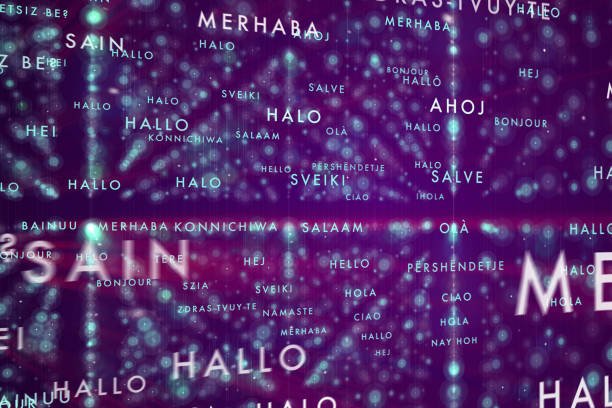Introduction to Çeviri
Çeviri, the Turkish word for translation, is an artwork and a technological understanding, encompassing the meticulous system of changing textual content or speech from one language to a few different. It is essential knowledge in our interconnected world, allowing pass-cultural conversation, fostering worldwide expertise, and facilitating the change of thoughts. This article delves into the intricacies of çeviri, exploring its ancient context, strategies, stressful conditions, and significance in present-day society.
Historical Context of Translation
The work of Çeviri translation dates once more thousands of years, with early examples decided in ancient civilizations together with Mesopotamia and Egypt. The translation of spiritual texts, similar to the Bible and the Quran, performed a pivotal feature in spreading religious teachings across distinct cultures and areas. Over time, the scope of translation extended to consist of literature, technological know-how, and philosophy, considerably contributing to the dissemination of knowledge and cultural trade.
The Process of Çeviri
The method of çeviri involves numerous steps: information on the source text, deciphering its means and rendering it into the aim language while retaining its unique motive, tone, and style. Translators ought to possess deep know-how of every source and goal language, in addition to the cultural nuances that affect language use. This method frequently requires studies, consultation with professionals, and now and then, innovative problem-solving to ensure accuracy and fidelity.
Types of Translation
Çeviri Translation can be categorized into numerous sorts, every with its private unique requirements and challenges. Literary translation includes translating works of literature, inclusive of novels, poems, and performances, wherein preserving the creative first-rate of the precise text is paramount. Technical translation calls for precision and know-how in specialized fields like medication, engineering, and regulation. Simultaneous and consecutive interpretation, utilized in meetings and diplomatic settings, name for quick thinking and skills in spoken language skills.
Challenges in Translation
Translators face numerous challenges in their artwork. Linguistic disturbing situations encompass coping with idioms, puns, and terms that do not have direct equivalents inside the goal language. Cultural worrying situations stand up at the same time as translating thoughts or customs specific to at least one way of life. Furthermore, the fast evolution of language and the emergence of recent terminologies require translators to usually replace their knowledge and adapt to new linguistic dispositions.
The Role of Technology in Translation
Advancements in the era have drastically impacted the arena of çeviri. Machine translation systems, which include Google Translate, have come to be more and more state-of-the-art, presenting brief and handy translations for normal use. However, human translators remain imperative for exquisite translations, mainly in fields requiring a deep understanding of context and nuance. Computer-assisted translation (CAT) equipment and translation memory structures also aid expert translators by way of increasing performance and consistency.
The Importance of Translation in a Globalized World
In our globalized global, the importance of Çeviri translation cannot be overstated. It permits international company transactions, diplomatic negotiations, and cultural exchanges. Translation maintains and promotes linguistic variety, permitting people to get the right access to literature, films, and distinctive cultural merchandise from spherical the world. Moreover, it performs a critical role in the dissemination of medical studies and technological improvements, contributing to worldwide development and development.
The Essence of Çeviri
Çeviri, the Turkish term for translation, is a multifaceted discipline that consists of more than simply changing phrases from one language to another. It is about taking pictures of the essence, tone, and context of the genuine text and conveying it because it needs to be in the goal language. This requires a deep expertise of every source and goal culture, similar to an eager revelation of language nuances.
Historical Evolution of Translation
The history of Çeviri translation is as vintage as the written language itself. Ancient civilizations, such as the Sumerians, Egyptians, Greeks, and Romans, engaged in the translation of a percentage of nonsecular texts, literature, and expertise. The translation of the Rosetta Stone, for instance, became vital in information on historic Egyptian hieroglyphs. Over the centuries, translation has played a pivotal role in cultural trade and the dissemination of thoughts.
The Translation Process
The Çeviri translation manner begins with an in-depth expertise of the source textual content. This involves no longer first-rate a literal interpretation but additionally, an assessment of its underlying means and context. The next step is to reconstruct this which means within the goal language, keeping the precise’s style and tone. This system frequently calls for multiple drafts and revisions to obtain a devoted and fluid translation.
Categories of Translation
Translation may be divided into numerous classes, each with its own private set of demanding situations. Literary translation offers fiction, poetry, and plays, focusing on creative expression. Technical translation consists of specialized fields like scientific, felony, and clinical texts, requiring specific terminology and accuracy. Subtitling and dubbing in media translation must synchronize with audiovisual factors, adding a few different layers of complexity.
Technological Advances in Translation
Technology has revolutionized the arena of translation. Tools like Google Translate and DeepL offer brief translations, however they frequently lack the nuance and accuracy of human translators. Professional translators use PC-assisted translation (CAT) systems and translation reminiscence structures to decorate performance and consistency. These device shops previously translated segments, which may be reused in destiny projects, saving time and effort.
The Global Importance of Translation
In our interconnected global, translation is greater essential than ever. It facilitates worldwide employers, permitting corporations to reap international markets. In international relations, translation is critical for easy verbal exchange amongst international locations. In the cultural realm, translation makes literature, movies, and different inventive works reachable to a broader target marketplace, fostering greater global understanding and appreciation.
Definition and Scope of Çeviri
Çeviri encompasses the conversion of written or spoken material from one language to any other, but its scope extends past mere word substitution. It involves an in-depth understanding of linguistic structures, cultural contexts, and problem-depend expertise. This approach ensures that the translated content resonates with the target market even while maintaining the authentic message’s integrity and motive.
Evolution of Translation Practices
The exercise of translation has advanced substantially from its ancient origins to fashionable times. In the beyond, translations have been regularly achieved through college students and clergymen who meticulously copied texts via hand. Today, the profession is supported by way of superior digital gear and assets, allowing translators to address large volumes of textual content more effectively and with more accuracy. This evolution displays the developing complexity and desires of world communication.
Cognitive Aspects of Translation
Translation isn’t absolutely a linguistic project but a cognitive one. Translators have to navigate among precise linguistic systems and cultural frameworks, frequently making complex picks about meaning and context. This cognitive manner entails hassle-fixing, critical thinking, and creativity, as translators try and discover the maximum appropriate equivalents in the purpose language without dropping the essence of the specific textual content.
Specializations in Çeviri
The situation of translation gives numerous specializations, every requiring specific competencies and understanding. Legal translation demands extensive expertise in prison terminology and ideas. Medical translation requires familiarity with medical jargon and processes. Literary translation emphasizes creative sensitivity to replicate the style and voice of the real creator. Each specialization addresses unique goals and necessities inside its domain, highlighting the flexibility and flexibility of the translation profession.
Ethical Considerations in Translation
Ethical troubles are paramount in the place of çeviri. Translators have to adhere to standards of accuracy, confidentiality, and impartiality. They regularly encounter touchy data that must be treated with discretion. Additionally, translators need to keep away from introducing personal biases into their paintings, making sure that the translation stays real to the unique content material. Ethical practices assemble trust and credibility in expert translation offerings.
Impact of Globalization on Translation
Globalization has exponentially elevated the call for translation offerings. As organizations amplify into new markets, the need for correct and culturally sensitive translations has turned out to be essential. This fashion has brought about the boom of the interpretation enterprise, with a growing wide variety of experts and companies that specialize in severa languages and sectors. Translation permits businesses to talk effectively with numerous audiences, fostering global cooperation and trade.
Training and Education for Translators
Becoming a gifted translator requires rigorous training and schooling. Many translators maintain ranges in translation studies, linguistics, or related fields. Specialized training programs and certifications, collectively with those provided using professional groups, offer more credentials and information. Continuous mastering is vital, as translators ought to stay up to date on language adjustments, agency traits, and technological advancements.
Conclusion:
In the quit, çeviri (translation) is a multifaceted vicinity that performs a vital position in facilitating conversation, fostering knowledge, and bridging linguistic and cultural divides in our more and more interconnected world. While generation keeps improving, human translators are critical for supplying accurate, nuanced, and culturally sensitive translations. As globalization persists and communication barriers are reduced, the call for expert translators will keep growing, highlighting the enduring relevance and significance of the interpretation profession.
Frequently Asked Questions approximately Çeviri (Translation)
What is çeviri?
Çeviri is the Turkish term for translation, which involves changing textual content or speech from one language into any other at the same time as preserving the actual meaning of, style, and context.
What are the critical elements and abilities required to be a translator?
Translators need proficiency in each of the supply and goal languages, cultural attention, extraordinary writing competencies, research skills, and problem count information in specialized fields if essential.
How does translation fluctuate from interpretation?
Translation involves changing written textual content from one language to another, at the same time as interpretation entails orally translating spoken language in real-time. Interpretation can be simultaneous (at the same time because of the reality of the speaker) or consecutive (after the speaker finishes a phase).
What kinds of translation offerings are available?
Translation services cover a great variety of needs, along with literary translation (novels, poetry), technical translation (medical, criminal), localization (adapting content material for specific areas), and interpretation (simultaneous, consecutive).
What position does technology play in translation?
Technology has revolutionized translation with gadgets like tool translation (e.g., Google Translate), PC-assisted translation (CAT) tools, and translation reminiscence structures, which grow overall performance and consistency. However, human translators remain vital for nuanced and accurate translations.
How do translators ensure accuracy and satisfaction?
Translators make certain accuracy and nice through thorough research, a couple of drafts and revisions, consulting challenges to be counted professionals, and the use of first-rate guarantee approaches consisting of proofreading and peer evaluations.
What are the unusual challenges in translation?
Common demanding situations encompass linguistic variations (idioms, metaphors), cultural nuances, preserving the precise tone and fashion, coping with issue-specific terminology, and making sure accuracy at the same time as retaining the particular message’s cause.
What ethical issues do translators face?
Ethical concerns consist of preserving accuracy, confidentiality, and impartiality. Translators must manage touchy statistics discreetly, avoid introducing non-public biases, and cling to professional requirements to construct belief and credibility.



